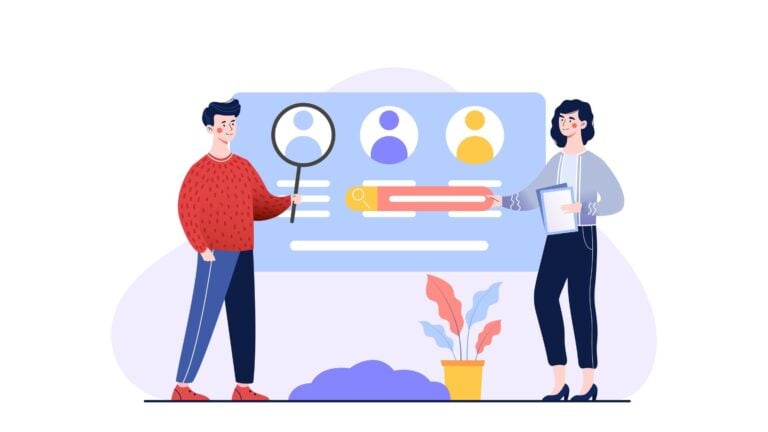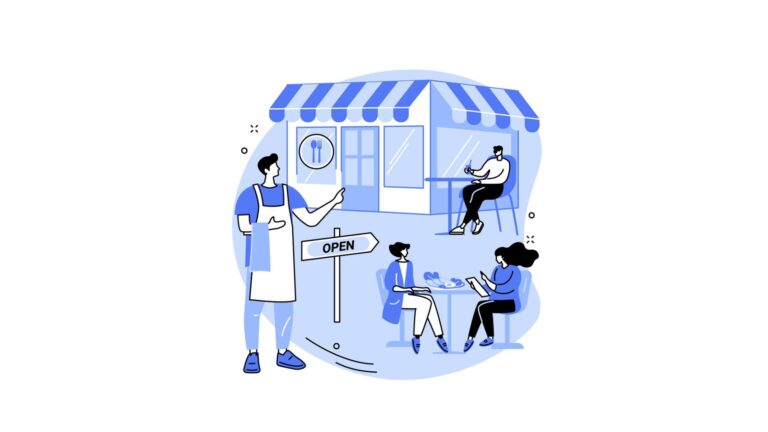A knowledge transfer plan can help you pass information among team members. Our guide below goes in-depth about the benefits of using a knowledge transfer plan and walks you through what to include in your own plan.
Keeping your employees highly skilled and well-informed is how you help them succeed at their jobs. Ultimately, it’s how you help your organization succeed, too. Knowledge transfer is a simple way to do this.
Knowledge transfer is a process of sharing information and skills among team members to prevent mishaps, miscommunications, and loss of critical knowledge. When you have solid knowledge transfer processes in place, you can avoid all that and streamline access to information for everyone on your team.
In order to make knowledge transfer possible, however, you need a plan.
In this guide, we discuss how to build a solid knowledge transfer plan and how it can help your business.
We’ve also included a handy template to help get you started.
Key Takeaways
- Knowledge transfer is the process of sharing knowledge and expertise within your business.
- It involves the sharing of explicit and tacit knowledge. Explicit knowledge is anything tangible and easily recorded, while tacit knowledge involves experiences, nonverbal skills, and information that can’t easily be put into words.
- The benefits of knowledge transfer include improving access to and spread of knowledge within your company, promoting diversity, acquiring new skills, encouraging respect and transparency, and keeping key information within the company.
- An effective knowledge transfer plan is a step-by-step process that helps you effectively share knowledge in your company.
What Is Knowledge Transfer?
Knowledge transfer is a formal process and a series of specific activities for sharing knowledge or information between one part of your business and another.
That could look like sharing between managers and employees or sharing peer-to-peer. It could also mean sharing information when a member of your team leaves the company.
The goal of knowledge transfer is to prevent knowledge loss. Usually, this looks like sharing different kinds of knowledge, categorized as tacit or explicit knowledge, with people in your company. It can also help fill information gaps when employees leave and can support the integration of multiple departments to reduce redundancy in your business.
In general, knowledge transfer involves the circulation of tasks, information, documents, processes, ideas, and more. As mentioned, knowledge transfer involves 2 main types of knowledge: tacit and explicit knowledge.
Here’s a breakdown of each:
Tacit (or implicit) knowledge
Tacit, or implicit, knowledge refers to information that’s difficult for employees to pass along or transfer verbally or in writing. It involves a person’s insights, experiences, and observations.
Examples of skills that are considered tacit knowledge include:
- The ability to make logical predictions
- Body language and humor
- The ability to recognize people on sight
- Emotional intelligence
- Knowledge of specific languages
- Leadership skills
Tacit knowledge is also more specialized and personalized because it’s stored in a person’s mind. It’s mainly acquired through cognitive processes (like observation, reflection, intuition, and more) and practice.
The best way to transfer tacit knowledge is through face-to-face activities or meetings. This allows givers and receivers of tacit knowledge to interact frequently. That, in turn, helps establish mutual trust.
Explicit knowledge
Explicit knowledge is any information quickly recorded, codified, and expressed for sharing and transferring. It’s much easier to document and record explicit knowledge compared to tacit knowledge.
It can be tricky to know whether you’re dealing with explicit or tacit information. Think of it like this: Explicit knowledge is straightforward information that’s shared and expressed between people.
It’s almost always clearly documented, often in written form. For instance, it could be a standard operating procedure (SOP) or a marketing report for the quarter. Aside from SOPs, onboarding documentation and how-to guides can also serve as explicit knowledge.
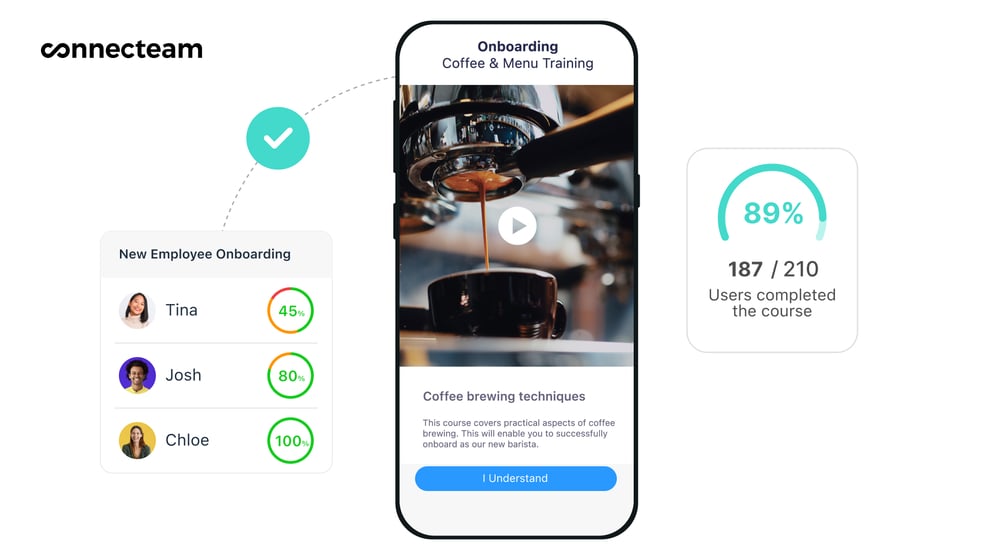
Four main types of knowledge transfer
While there are 2 types of knowledge involved in knowledge transfer, there are 4 main types of knowledge transfer itself. These are:
- Tacit to tacit: Involves transferring intangible knowledge from one person or group to another, who keeps that knowledge in a tacit form.
- Tacit to explicit: Also called externalization. It involves converting tacit knowledge into explicit knowledge, such as physically documenting someone’s personal insights in meeting notes.
- Explicit to explicit: Involves creating new information from existing explicit knowledge, such as digitizing a physical report.
- Explicit to tacit: Also called internalization. It involves teaching explicit knowledge to a person or group who retains it in their minds. An example would be a person sharing HR policies with a team, who will retain the information mentally.
Why knowledge transfer is important
Knowledge transfer has a multitude of different benefits, which makes it important for businesses.
For one, it helps improve time management while training new hires in their specific roles. When your team participates in knowledge transfer, managers know the exact information to share with new employees, who won’t waste time lost and confused during onboarding and training. Plus, effective knowledge transfer frees up your time to focus on other aspects of onboarding, like introducing new hires to the rest of the team.
This Might Interest You
Read our comprehensive guide to a successful employee onboarding process in 2025.
Knowledge transfer also helps develop your employees. They can learn skills and information from others in the organization, growing in ways they may not have if knowledge transfer wasn’t standard practice at your company.
Additionally, knowledge transfer helps existing employees transition into a departing team member’s role. It helps your company maintain key information, even when you’re dealing with staff turnover.
At the same time, it better equips all of your employees to be successful in their roles, helping them be more productive.
Besides this, knowledge transfer is important because it fosters innovation. This can lead to new ideas, more motivated employees, a better business reputation, stronger customer satisfaction, and more.
Finally, the process of knowledge transfer often involves creating a centralized place to store knowledge, which helps prevent information loss. This reduces the chance of important pieces of data being lost, deleted, or overlooked by team members.
What Are Knowledge Transfer Plans?
Knowledge transfer plans are strategies that help businesses move information from one part of the organization to another. In most cases, this looks like moving information from one person or department to another.
Essentially, these plans are roadmaps for sharing knowledge—detailing what the knowledge is, how it will be shared, who will share it, and who will receive it.
Knowledge transfer plans can be either written documents or verbally shared strategies. In any case, the goal is the same: to ensure knowledge is successfully transferred within an organization.
These plans usually involve 4 key phases:
- Identify key knowledge
- Capture that knowledge
- Document the knowledge
- Share the knowledge
These phases allow businesses to move knowledge from one individual or department to another without losing or misinterpreting information.
The Benefits of Knowledge Transfer Plans
There are a number of ways you can benefit from creating and implementing a robust knowledge transfer strategy. You can speed up how long it takes you to gather and spread knowledge, better incorporate ideas into other departments, boost innovation at your company, and more.
They can also help you:
Improve workplace productivity and efficiency
These plans streamline knowledge-sharing, making it easier for employees to access information necessary for them to do their jobs. They won’t waste time asking questions or going back and forth communicating with other departments. This gives them more time to focus on their work.
It also enables them to make better decisions and solve problems faster and more efficiently. This keeps your employees—and your organization—productive.
At the same time, when employees are equipped with key pieces of knowledge, they’re better prepared to get the job done right the first time around. That saves them from making mistakes and having to re-do certain parts of their job.
Enhance collaboration
Knowledge transfer plans can also make it easier for departments to work together. They facilitate smooth information-sharing between members of different departments, enabling them to use each other’s knowledge, skills, ideas, and more to work toward greater company success.
Additionally, these plans prevent information from becoming siphoned into one department. Instead, there’s a process in place for sharing knowledge among team members and departments when they need it. This improves overall access to information within the company, which makes collaboration smoother all around.

Increase engagement
Knowledge transfer plans help experienced colleagues and subject matter experts more easily share information with others at your company. This exposes your workers to ideas, skills, and information they may not have heard of before—and may get excited about.
This can foster an interest in new skills, encouraging your employees to pursue professional development opportunities that can make them better at their current jobs or skilled to take on new responsibilities. This newly sparked interest motivates employees—in turn, making them more engaged.
What To Include in a Knowledge Transfer Plan
With the definitions out of the way, let’s discuss what to include in a knowledge transfer plan.
In general, a good knowledge transfer plan will include:
- Key objective: What’s the end goal of transferring this information?
- Clearly defined knowledge: What are you aiming to share? Is the information tacit or explicit?
- Who’s sharing the knowledge: Who’s the person, team, or department that owns the knowledge?
- Who’s receiving the knowledge: Who’s the person, team, or department the knowledge will be given to?
- Who benefits from the knowledge transfer: Apart from the giver and the receiver, who else will gain benefits from the information being shared?
- Methodology: How will you share the knowledge? For example, you could choose mentorship, paired work, or work shadowing.
- Tools: What tools will you use to facilitate knowledge sharing? For example, digital collaboration platforms, learning management systems, or online knowledge bases.
- Deadline: When does the information need to be shared?
- Location: Where will the information be stored? For example, will it be stored in a computer database, such as Google Drive or Dropbox, or in a physical location, such as a filing cabinet?
- Follow-ups: How will you follow up with those involved in knowledge sharing to track progress and gather feedback?
- Measurement: How will you measure and quantify the success of the knowledge transfer?
Answering these questions will help you define the who, how, what, why, when, and where of transferring knowledge. You can easily develop an effective plan that everyone can follow.
Exclude irrelevant information
Besides knowing what you should put in a knowledge transfer plan, it’s also important to know what not to include. This will mean looking at what pieces of information aren’t relevant to your objective and leaving them off the table.
For instance, let’s say you’re transferring knowledge about your company’s hiring policies. In this case, you’ll want to leave out other HR information that isn’t directly related to hiring, like policies regarding lay-offs and terminations.
Otherwise, you can overwhelm team members and make it more difficult for them to absorb and use new information.
You can also read our 12 Effective Ways to Share Information with Team Members guide.
Execute a Knowledge Transfer Plan in 7 Steps
To ensure a smooth process, we have prepared a handy knowledge transfer checklist. Each of the seven steps outlined below will provide you with clear guidance on what needs to be accomplished.
Let’s dive in and start making knowledge transfer a breeze.
Step 1: Determine your objectives and needs
The first step in creating a knowledge transfer plan is to determine your objective and figure out the information you need to gather.
Setting an objective often involves looking at which people or departments are vulnerable to knowledge loss and which information is critical knowledge that needs to be preserved. You’ll also need to look at who’s in charge of that information and whether you actually need knowledge transfer to preserve it.
An example objective might be to equip a current employee with the skills and knowledge needed to take over a departing team member’s position. Or, to have your sales department learn skills and traits from your marketing department in order to improve collaboration.
Pro Tip
The SMART (specific, measurable, achievable, relevant, and time-bound) goal formula can help you set clear goals for knowledge transfer. We explain more about SMART goals and how to write them in our in-depth guide.
From there, you can determine what information you need to gather. Look at the knowledge a person or group needs to use on a daily basis. What’s required for their roles or the function of their team or department? Is it mostly tacit knowledge, like leadership skills, or explicit knowledge, like skills in operating heavy machinery?
You should also figure out which knowledge is exclusive to certain people or departments. Think about how each team works and which team members or departments know how to do tasks that others should know too. You can also think about who people generally ask for help when they’re stuck trying to complete a task. You’ll want to gather information from these individuals.
Finally, you can come up with a list of information that needs to be shared among team members and jot it down in your knowledge transfer plan.
Step 2: Gather the information
Next, you’ll need to actually gather the information.
This can be tricky because you might be dealing with a mix of both tacit and explicit knowledge. This means you’ll have to use a variety of methods to gather information, such as:
- Conducting direct observation/job shadowing (great for tacit knowledge)
- Watching or recording videos (useful for tacit knowledge)
- Conducting interviews (great for tacit knowledge)
- Workshops and informational sessions (useful for both tacit and explicit knowledge)
- Looking at written documents (great for explicit knowledge)
- Looking at shared documents in collaboration platforms (useful for both tacit and explicit knowledge)
- Reviewing policy and procedure manuals (great for explicit knowledge)
- Listening to or capturing audio recordings (great for tacit knowledge)
- Conducting surveys (useful for both tacit and explicit knowledge)
- Holding focus groups or group discussions (useful for both tacit and explicit knowledge)
Step 3: Store the information properly
Once you have all that information, you’ll have to store it somewhere. You can store the information physically such as in a filing cabinet, or digitally.
Either way, you may have to transcribe certain pieces of information so they’re in either digital or physical format.
For example, if you’ve captured a video walkthrough of how to perform a certain task, you’ll want to store it on a USB if you’ll be keeping knowledge in a physical location. If you have physical written memos and are storing knowledge digitally, you’ll need to digitize the memos before storing them.
You should also be mindful of privacy and storage regulations. When you gather knowledge, some of it may include sensitive data. Be sure to read up on any safety and privacy regulations that may impact how you choose to store your information.
Pro Tip
When storing information digitally, look for features like end-to-end encryption, 2-factor authentication, and customizable user permissions to protect your data from unauthorized users and hackers.
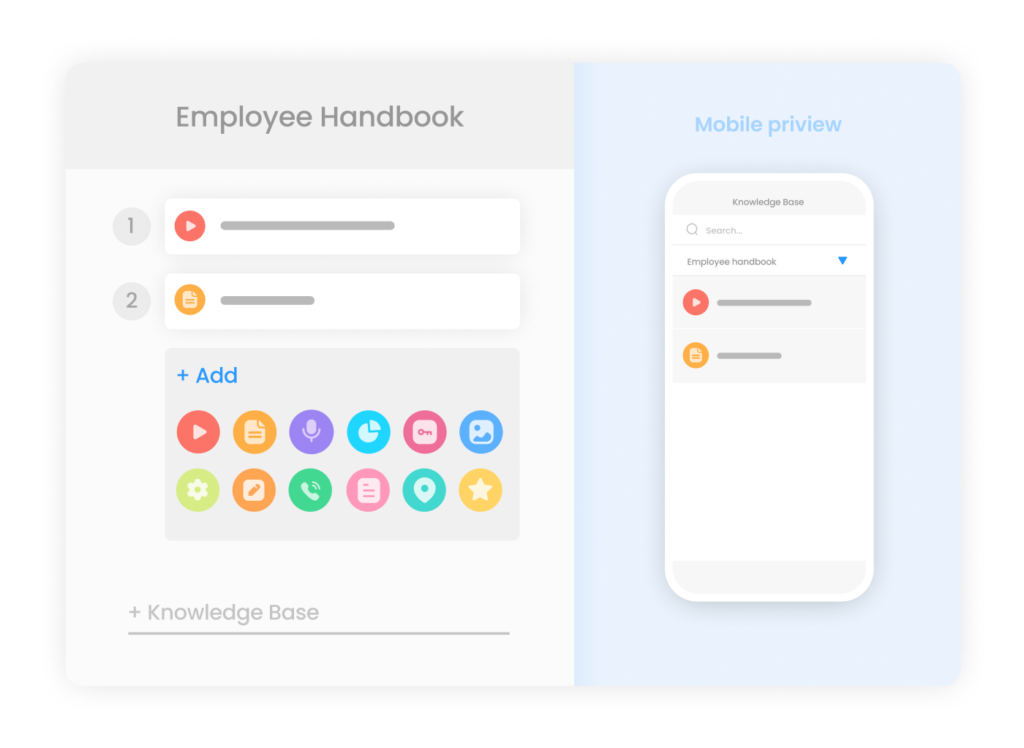
Step 4: Choose your tools
Before you can begin transferring the knowledge, you must figure out which tools you’ll use to do it.
Some of these tools might be physical, such as written training materials or props needed for an in-person training session. Others might be digital, such as video conferencing platforms like Zoom or software that lets you make interactive presentations.
To pick your tools, think about the best way to share the information you’re aiming to transfer. For example, it might be best to use a video conferencing platform to transfer tacit knowledge like a salesperson’s intuitive customer service skills. For explicit knowledge like the proper procedure to close a restaurant for the night, written documents might be ideal.
Be aware that you may need to use a mix of physical and digital tools during your knowledge transfer process, so plan accordingly.
Step 5: Pick your methodology and execute the transfer
Next, it’s time to choose a methodology for delivery.
There are a number of different knowledge transfer delivery methods you can pick from. These include:
- Mentorship: Great for sharing tacit knowledge, this involves a more experienced person training someone with less experience.
- Work shadowing: Allowing new learners to shadow a person as they go about their daily work routine to see how they put knowledge into practice.
- Peer-to-peer learning: Involves working in pairs or groups to share tacit and explicit knowledge.
- On-the-job training or guided experience: Involves an experienced employee training another team member on tasks, best practices, and more during their normal workdays. This helps transfer both tacit and explicit knowledge. It’s great for kinesthetic, or “hands-on,” learners.
- Instructor-led learning: As the name suggests, this is when a subject matter expert or highly skilled employee leads a learning session to teach others about a particular topic. This can either be in-person (with a physical presentation or lecture) or online (with a digital presentation or lecture).
- Simulations and role-play exercises: With this method, individuals participate in a work situation in a controlled environment. This teaches them proper skills and behaviors. This method works well for transferring tacit knowledge.
- E-learning and technology-led learning: This involves using digital platforms with videos, digital training materials, quizzes, and other digital activities to share knowledge.
- Video instruction: Involves having a pre-recorded or live instructor dictate virtual lessons to an individual or group.
- Coaching: This is when a more experienced employee works closely with another team member to develop their skills, improve their knowledge, and ensure they’re performing well.
- Social engagement: Involves using an interactive platform that allows employees to look up information and communicate with one another to promote knowledge transfer.
Remember, these are just a few examples of different knowledge transfer methodologies. You’ll need to choose the ones that make the most sense for your business in order to ensure successful transfer of knowledge.
Depending on which methodology you choose, you may need to go back and add new tools to your knowledge transfer plan.
After you’ve picked your methodology (or methodologies), execute your knowledge transfer!
Step 6: Measure the transfer’s success
After you’ve completed your knowledge transfer program, it’s time to measure its success.
First, you’ll need to determine the key performance indicators (KPIs) that will signify the transfer was successful. Some examples include:
- Improved customer satisfaction surveys
- Fewer product defects
- Increased productivity or efficiency in completing tasks
- Improved compliance or adherence to regulations
- Fewer errors made in certain processes
- Faster customer service response times
Note these down in your knowledge transfer plan, then compare the results of your transfer against them. Have your employees been successful, or have they missed the mark? Is there more information that needs to be transferred or areas for improvement that need to be identified?
This evaluation is key to ensuring your knowledge transfer processes are effective.
Step 7: Gather feedback
Finally, you must follow up with all parties involved. Touch base with the person or people who shared the knowledge, those who received it, others who benefitted from the knowledge being transferred, and anyone else who played a role in the process.
You can check in face-to-face, over the phone, via email, or through instant messaging and ask for your employees’ thoughts and opinions on the process. You might even create and share a survey asking your employees for their feedback.
Following up can give you valuable insight into what worked and what could be improved. This, in turn, can help you refine your approach the next time you need to share knowledge in your company.
Knowledge Transfer Template
Since every company is different, a universal knowledge transfer plan doesn’t exist. But using a basic knowledge transfer plan template as a starting point is a great idea. You can customize it to create an effective strategy that works for your business.
We’ve whipped up a knowledge transfer template you can use to get started:
| Knowledge Transfer Plan | |||||||||||||||||||||||
| Name of organization | Month, Year | Name of individual creating the plan | |||||||||||||||||||||
| What: The skills, information, and knowledge to be shared | |||||||||||||||||||||||
| Why: Your objective for sharing the knowledge/the goal you aim to achieve | |||||||||||||||||||||||
| Who: Owner/sharer of the knowledge | Recipient of the knowledge | Who else benefits from the knowledge being shared or received | |||||||||||||||||||||
| How: Methodologies to be used | Tools to be used | ||||||||||||||||||||||
| When: Deadline for the knowledge transfer | |||||||||||||||||||||||
| Where: Location where the transferred knowledge will be stored | |||||||||||||||||||||||
| Follow-ups: How many in total you need to conduct | Date and time of follow-up(s) | Names of people to follow up with | |||||||||||||||||||||
| Measurement of success: How you will measure the success of the knowledge transfer | |||||||||||||||||||||||
How Connecteam Can Help You Transfer Knowledge at Your Business
One of the most important components of a knowledge transfer plan is the methodologies and tools you’ll need to share information. Connecteam, an all-in-one work and knowledge management platform, offers several tools that streamline knowledge-sharing.
Let’s take a look at a few standouts.
Share knowledge through customized training
For starters, Connecteam offers powerful employee training features that make sharing knowledge a breeze.
You can create and upload your own training materials, as well as create custom courses from scratch or by using one of Connecteam’s templates. Add videos, images, audio notes, and more. Then, tack on a quiz to gauge how well employees have retained training information. You’re also able to segment modules so it’s easier for employees to complete training without getting overwhelmed.
Employees can access courses and materials from their mobile devices or desktops, and there’s no limit on the number of employees that can use Connecteam. Train a handful of teams or your entire company!
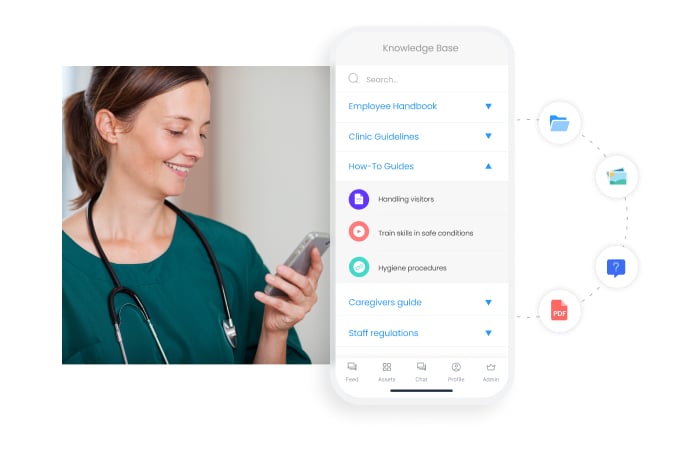
Plus, Connecteam’s training features can serve as a methodology for your knowledge transfer plan. You can create and store e-learning modules, video training, instructor-led sessions, and more directly on the platform. Connecteam even has an event mangement feature you can use to schedule in-person training sessions.
All of this leads to smoother knowledge transfer within your organization.
Store and access information via the knowledge center
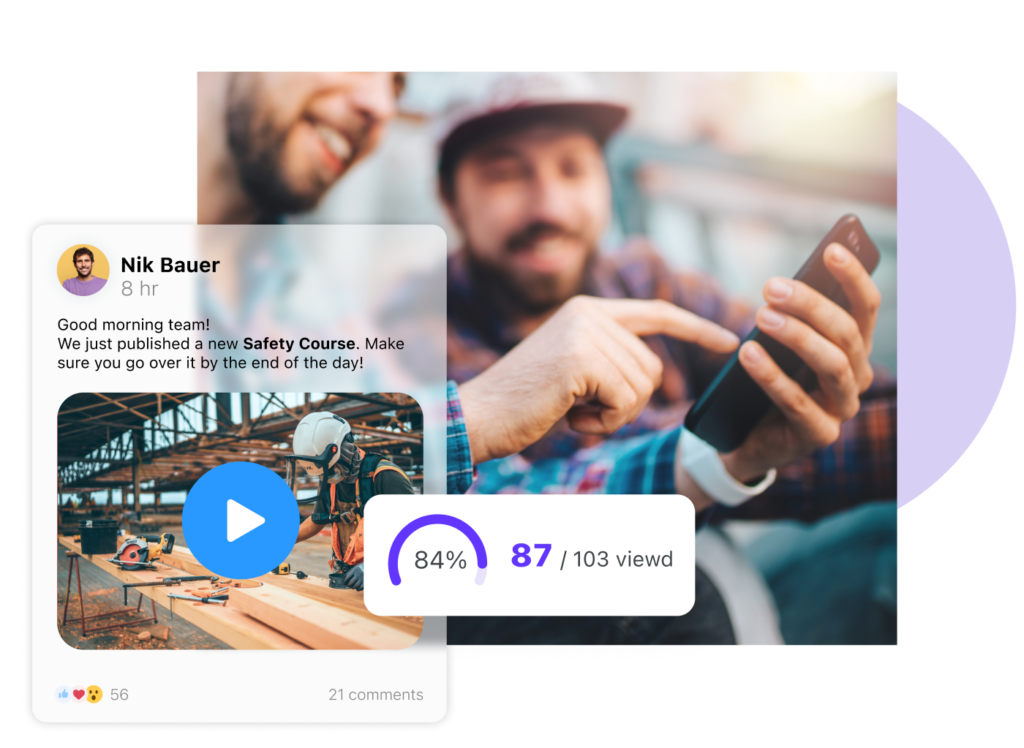
Connecteam’s knowledge center feature allows you to handle the storage aspect of knowledge transfer. Store all of your company’s important information in one central location that employees can easily access regardless of their physical location.
A couple of other features of the knowledge base include:
- No storage limitations, so you can store as much as you need to.
- End-to-end data encryption, so your data is protected and adheres to privacy regulations.
- Automatic data syncing, so you know that the information you have stored is never outdated. Recent changes are always reflected in documents!
- Custom user permissions, so you can specify which employees can view which files.
Keep employees informed using the in-app chat and updates feature
Connecteam’s communication tools can help make the knowledge transfer process easier for your company.
First, the built-in chat feature lets you and your team members communicate with each other in real time in one-to-one or group conversations. Send messages with videos, images, audio notes, and file attachments to transfer knowledge quickly and easily.
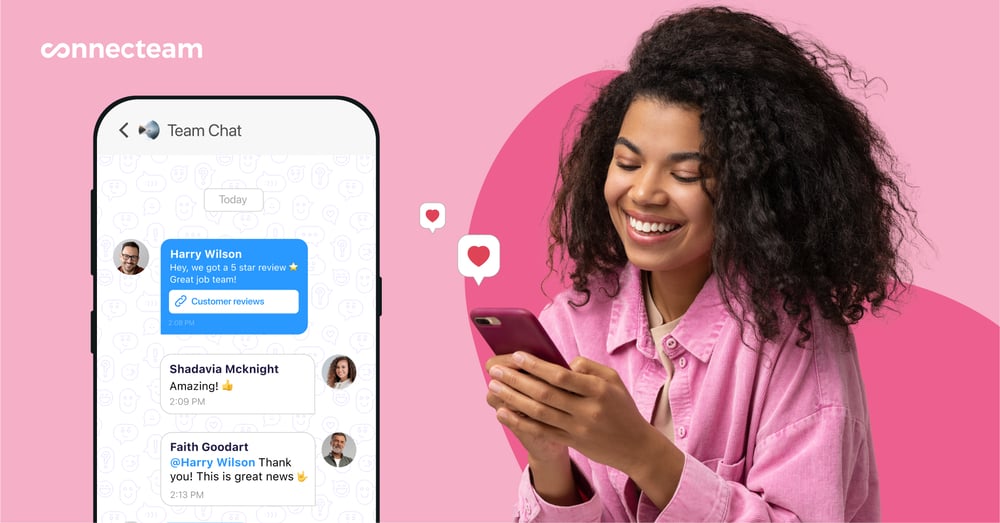
There’s also the updates feature, which enables you to share information with everyone in your organization or just certain groups of employees. You can choose who receives the information based on department, function, name, and other factors.
As a manager, you can see the number of views your posts get, and Connecteam will send notifications and reminders to workers’ devices so information doesn’t get missed.
Both of these features make it possible to spread information easily throughout your organization and can be tools you use to execute your knowledge transfer plan.
Gather feedback with surveys and polls
You can also use Connecteam’s surveys and polls feature to gather feedback from employees about your knowledge transfer processes.
The platform provides survey templates, but you can just as easily create your own using a variety of different question types—including yes/no, multiple-choice, and open-ended questions. There’s also an option to send automated reminders to employees to complete surveys.
Did You Know?
Connecteam has a ton of other features—for everything from scheduling and time tracking to rewards and recognition to task and project management and more.
Get started with Connecteam for free today!
Conclusion
Knowledge transfer involves the sharing of information among team members within an organization. It helps improve communication and make information more accessible. In order to do that, having a knowledge transfer plan in place is key.
A solid knowledge transfer plan helps you carry out the process of knowledge transfer clearly, concisely, and effectively. It can help boost productivity, collaboration, employee engagement, and more across your business.
Regardless of what type of knowledge you’re transferring, it’s essential to follow a step-by-step guide similar to what we presented in this article. We also recommend using a digital work management tool like Connecteam to help streamline knowledge-sharing at your company even further.
Get started with Connecteam today!
FAQs
What is the main purpose of a knowledge transfer?
The primary purpose of transferring knowledge is to improve the spread of and access to information within a company. As a result, it helps prevent information loss, encourages collaboration, boosts efficiency, and more.
What are the 4 types of knowledge transfer?
The 4 types of knowledge transfer are:
- Tacit to tacit
- Tacit to explicit
- Explicit to explicit
- Explicit to tacit

